The new jungle garden – how to create a lush, contemporary haven
The jungle garden look takes the contemporary, lush layers of today’s houseplant-filled interiors out into the garden.
That’s according to a new book, The Jungle Garden by Philip Oostenbrink. I’ve also interviewed him on video, if you prefer watching. See New Jungle Style on the Middlesized Garden YouTube channel.
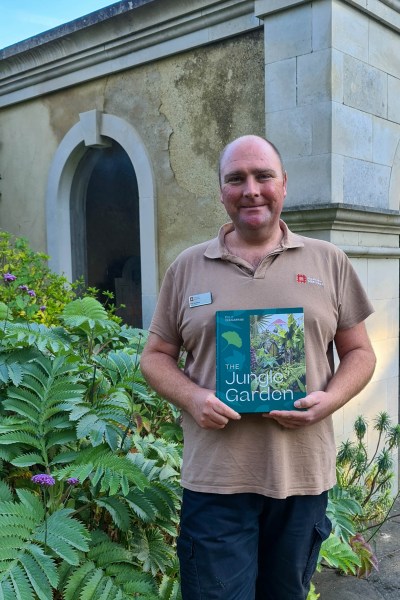
Philip Oostenbrink with The Jungle Garden, available from Filbert Press, Amazon and bookshops.
Note that links to Amazon are affiliate, see disclosure. Other links are not affiliate.
This style of garden is a foliage-based green haven, with layers of plants and different leaf shapes. And you don’t have to live in a tropical country. It can be achieved in cool climates.
Philip’s own garden is in South East England. It’s a jungle garden and he estimates he lifts and stores less than 10% of the plants in winter.
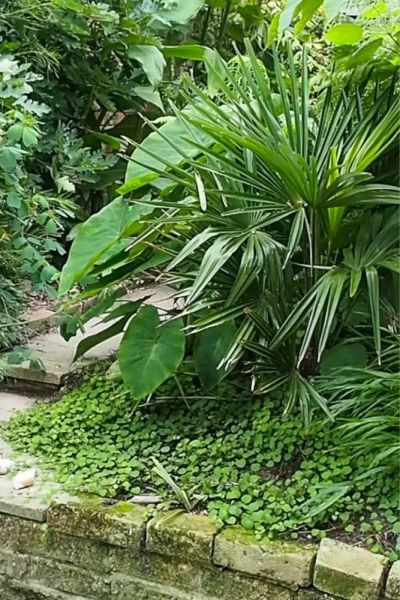
Trachycarpus, shown here in Philip’s own garden with Colocasia ‘Pink China’ demonstrate the leaf contrast of a jungle garden. The tiny-leaved ground cover plant below them is Fuschia procumbens. Trachycarpus (Fan palm) and the colocasia both over-winter well in most UK areas.
What is a jungle garden?
‘I see a jungle garden as being densely planted. It’s much more about the foliage than the flowers,’ says Philip. ‘Plant lots of plants, so you can’t quite see what’s at the other end.’
That’s why it works to make tiny gardens seem larger, because you can’t quite see the boundaries.
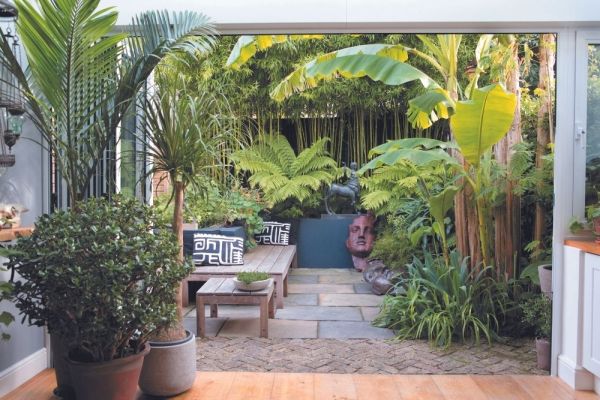
The ‘garden room’ style from The Jungle Garden. Plants make it hard to see where the house ends and the small courtyard begins, creating a sense of living in a green haven. Photograph by Sarah Cuttle.
A jungle garden is a really good way for a plant lover to pack lots of interesting plants into a small space. Philip himself discovered the style when he found himself with a small garden of only around 10 square metres and a huge collection of plants.
Philip thinks that this look suits quite a wide range of gardens. He is head gardener at Walmer Castle, where he has just begun planting a jungle garden in the moat. ‘Many people look down on the moat, so it would look good to see big, lush foliage and different patterns of foliage.’
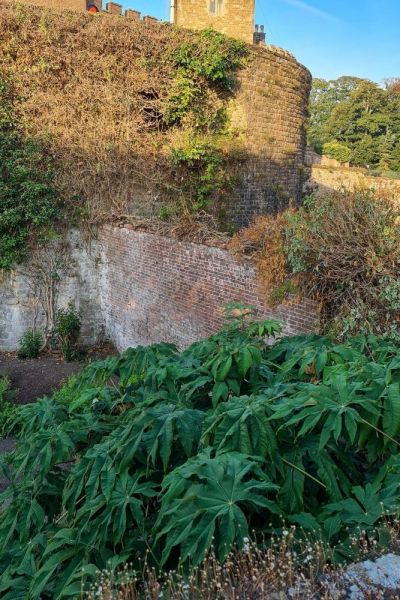
This Tetrapanax ‘Rex’ is one of the first ‘jungle’ plants that Philip has introduced to the moat at Walmer Castle.
Philip’s garden has featured on The Middlesized Garden before in Why a Small Garden Needs a Big Idea.
Different styles of jungle garden
In The Jungle Garden book, Philip identifies a number of different styles of garden that work for the jungle look. These include the ‘Garden Room’. This is a contemporary open plan room which opens out onto a terrace. The plants inside and out flow into each other so that you can’t see where the house ends and the garden begins.
There is also the Potted Jungle, where most of the plants are in pots. And ‘Jungle Living’ is where the garden seating or table is like a clearing in a jungle, surrounded by plants and shielded from prying eyes.
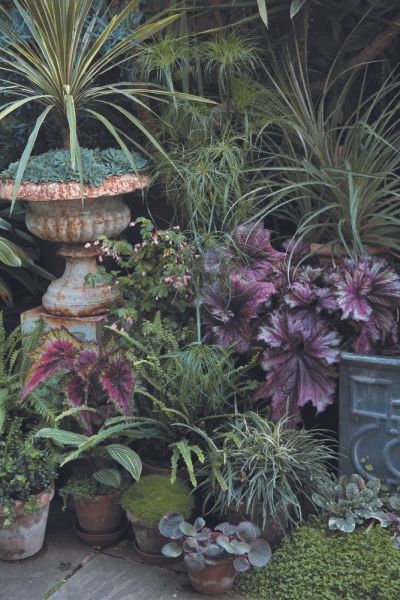
Layers of pots and plants create a jungle look in a small garden or courtyard as well as inside the home. Pots make it easy to take tender plants indoors during winter. Photo from The Jungle Garden by Sarah Cuttle.
Jungle gardening has become popular in small, city gardens because the layers of planting make even a small over-looked patio feel private and secluded.
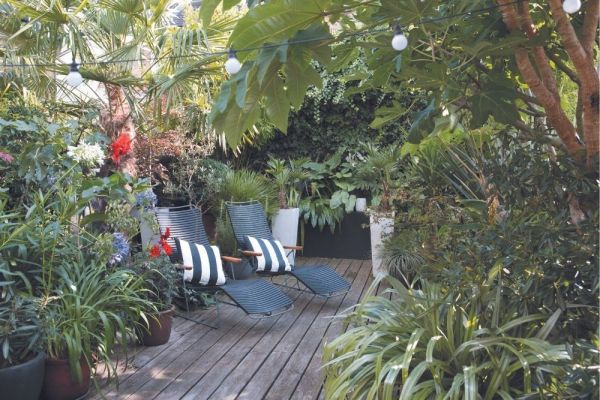
Jungle living from The Jungle Garden book. The chairs appear to be an oasis in dense growth,. This may be a courtyard garden or it may be huge. No-one can tell – and it’s very private. Photo by Sarah Cuttle.
See this post for more about how to increase your garden privacy in small gardens.
A jungle garden is all about layers of foliage
Philip says that a jungle garden is all about the foliage. His book explains the main different leaf shapes, and he suggests you contrast these with each other. So a ‘palmate’ leaf is like an open hand while a ‘linear’ leaf is very much a straight line. ‘Place a plant with a palmate leaf and a linear leaf next to each other for contrast,’ he suggests.
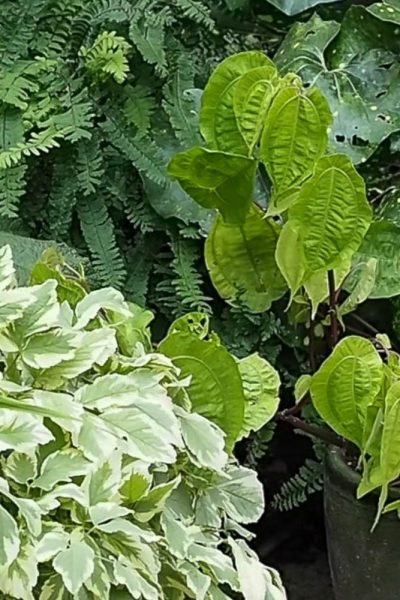
The heart-shaped leaves of Pilea insolens contrast with the feathered leaves of variegated ground elder (kept in a pot) in Philip’s garden.
What’s the difference between a tropical garden and a jungle garden?
A tropical or exotic garden is one which relies on vivid colour as well as foliage shapes and texture. Whereas Philip sees a jungle garden as being dominated by foliage. ‘Plants are plants, of course, which means that most of them do flower,’ he says. ‘So you have flowers in the jungle garden but it’s not the main point.’
The tropical and exotic gardens use layers too, as you can see in this post on how to have an exotic garden in a cool climate.
But Philip thinks that the jungle look means you can work with hardier plants. Many vividly colourful flowers and plants, such as dahlias and bromeliads are not winter hardy, while a number of recommended plants in Philip’s book are hardy down to quite cold temperatures. He gives the hardiness of each plant in a list at the back.
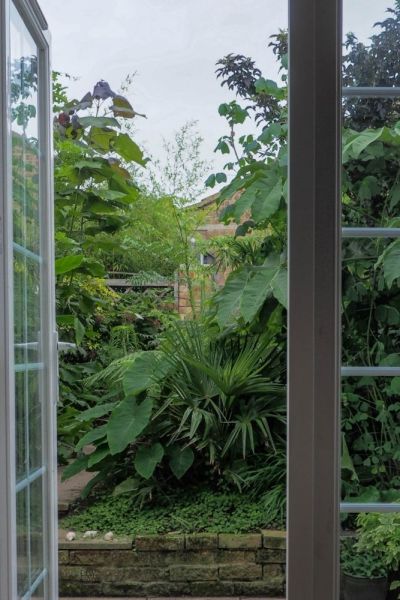
Because a jungle garden is so densely planted, you can’t see where the boundaries are. Even a very small garden is lush and private. This is Philip’s own garden viewed from the house.
How do you care for a jungle garden?
When a garden is packed with plants, they need the soil to be in good condition so that they can take up the nutrients. Philip adds a layer of well rotted manure or other soil improver once a year (or sometimes once every two years.)
He says that because the jungle garden look is so densely packed with plants, ‘there’s hardly any light on the soil, so there’s very little weeding.’
And although he waters his garden in a dry spring, before the leaf canopy is fully re-established, there is very little summer watering. ‘Because there are so many leaves, the sun doesn’t get the chance to dry out the soil.’
About 10% of the plants have to be dug up and stored over winter in a frost-free dry place.
So apart from the over-wintering, jungle gardening is reasonably easy-care.
What about the jungle look for a front garden?
A front garden has a different aspect to your back yard. Philip’s front garden is hot and sunny, while his back garden is shady.
So he uses plants that are more sun-loving and drought-tolerant in the front than the back.
A front garden may also be affected by local regulations covering the height of plants. That’s true in Philip’s case, so he doesn’t plant anything that’s higher than about 2 metres/6ft.
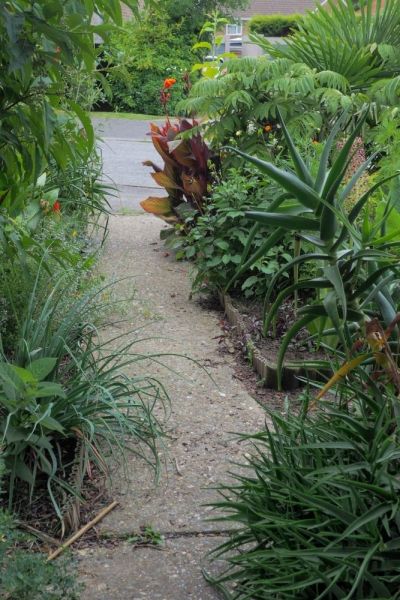
Philip’s front garden is sunnier than the back garden, and it is equally crammed with plants.
There’s more front garden inspiration in this post on Low Maintenance Front Gardens.
The best five starter plants for a jungle garden
At the end of Philip’s book, The Jungle Garden, there is a directory of good plants to choose if you want to create this look, plus the information you need to know on how hardy they are and other growing information. So I asked Philip for five top starter plant recommendations.
Tetrapanax (Tetrapanax papyrifer ‘Rex’)
This is probably the king of the jungly-looking plants. It looks exotic but can survive down to around minus 10C/14F. If it does get damaged by frost, the big, distinctive leaves should grow back.
It is one of the first plants that Philip has added to the moat at Walmer Castle as a starter for the jungle garden there. Tetrapanax is a good plant for creating the upper canopy in a garden.
Tetrapanax ‘Rex’ is one of the keynote plants in Mark Walker’s shady ‘secret garden’ in Margate in A Garden With a Sense of Place.
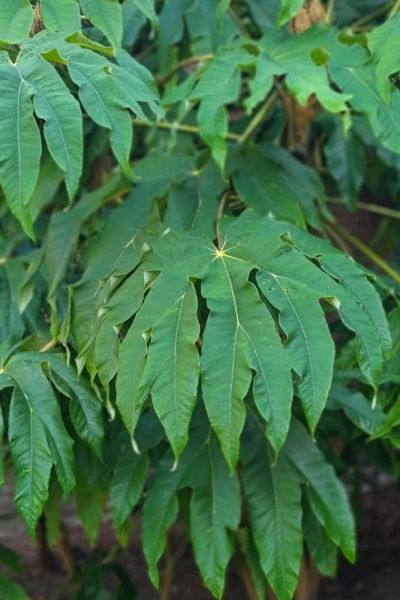
The huge leaves of tetrapanax ‘Rex’ make it an excellent canopy plant for a jungle garden. Shade loving plants will grow beneath it.
Tree ferns (Dicksonia Antartica)
This is another good canopy plant, although you can buy quite small ones. Tree ferns grow exceptionally slowly so buy the size you want. It will tolerate a little frost, down to minus 5C/23F. There’s more about growing tree ferns in a cool climate here.
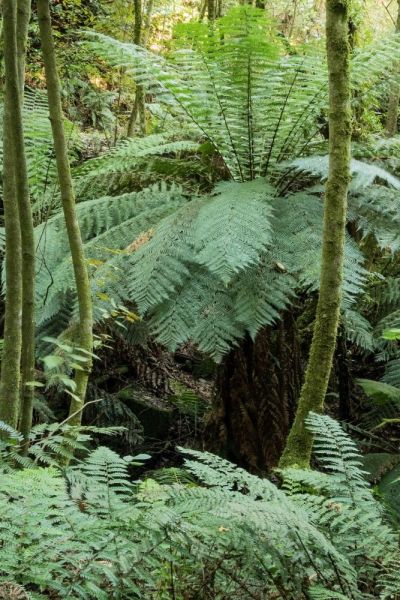
These tree ferns are growing wild in a strip of original rainforest near Melbourne, Australia. The winters here are as cold as many UK winters, so although the tree fern looks tropical, it can be grown in many UK gardens with some winter protection on the coldest days. This shows the natural layered effect of jungle planting.
Colocasia ‘Pink China’
This is one of the hardier colocasias. You can leave it in the garden during the winter or bring it in and treat it as a houseplant, says Philip.
Colocasia ‘Pink China’ was one of the plants featured in Kate Mason’s award-winning tropical border at BBC Gardeners World Live.
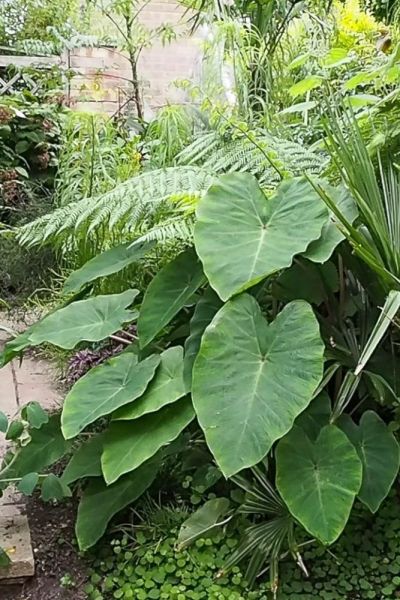
The heart shaped leaves are Colocasia ‘Pink China’, a hardy colocasia that can cope with most UK winters.
Fig tree (Ficus carica)
The leaves of a fig tree are quite exotic and many fig varieties are quite hardy, going down to minus 15C/5F. If you want to grow a fig for fruit, it’s often best to espalier it against a sunny wall, says Philip. But it also works well as a very ornamental plant.
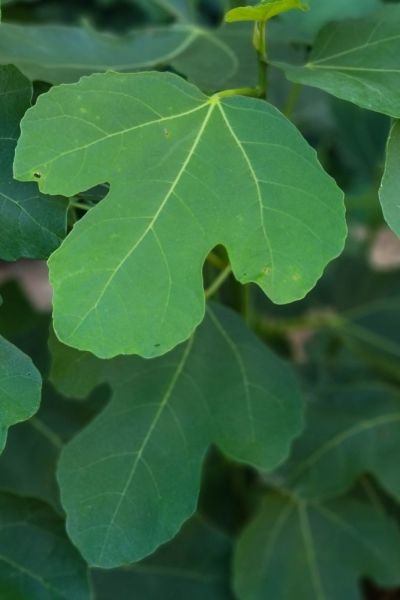
Fig tree leaves are distinctive and decorative, making fig a good choice for a jungle garden. You can also get smaller ficus varieties which work as houseplants.
Hakonechloa macra (Japanese forest grass)
The leaves are slim bright spears, so it’s a good low-growing contrast to the bigger, chunkier leaves of some of the other plants. It’s very hardy, down to minus 20C/minus 4F. A very useful grass that loves dry shade.
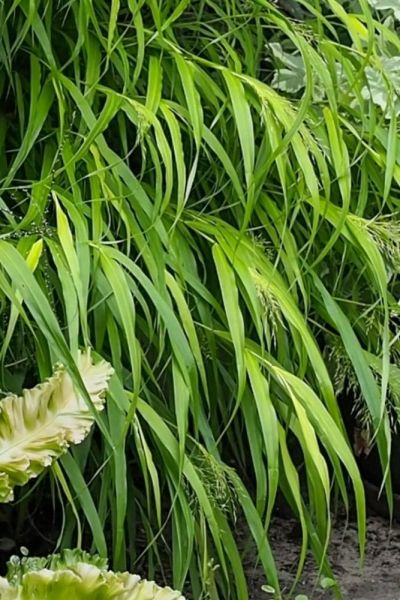
The slender linear leaves of hakonechloa macra and its love of shade make it a very good understory jungle garden plant.
More about The Jungle Garden
Like many good gardening books, reading The Jungle Garden will teach you more about plants and gardening generally. Although there are plenty of photographs and illustrations, this is not purely a visual book. It’s packed with useful information and is very readable.
There’s a section on different jungle garden styles. but it is essentially about the plants, with a very useful listing of plants and their hardiness at the back.
If you’re thinking of giving a gardening book as a present, this would be ideal for someone who loves houseplants but has either only just acquired a garden. It would also be good for those who have small courtyard gardens and balconies, as well as for ‘plant geeks’ generally.
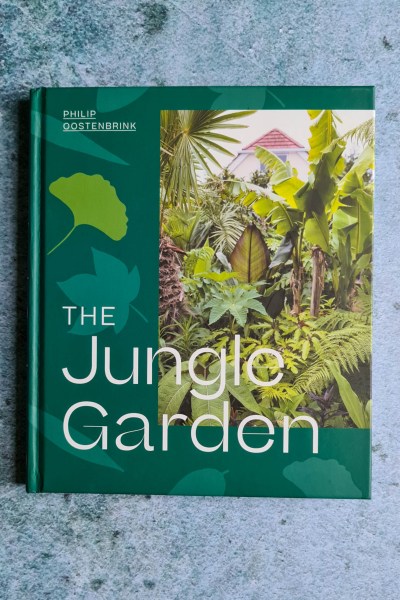
The Jungle Garden is available from the publishers Filbert Press
Pin to remember jungle garden tips
And do join us for a free weekly email with tips, ideas and inspiration for your garden.
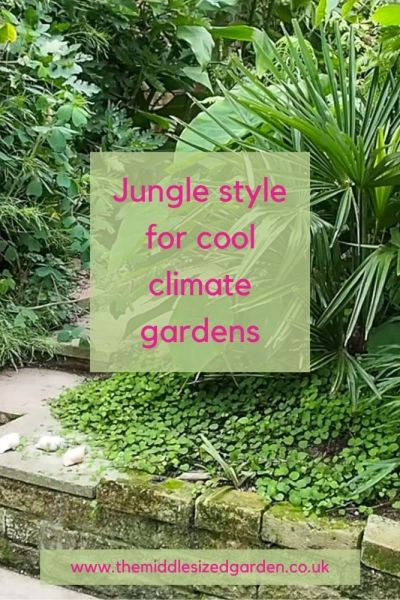
























Great blog post! I am very much into the idea of a jungle garden.
Thank you!